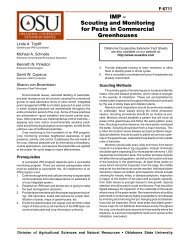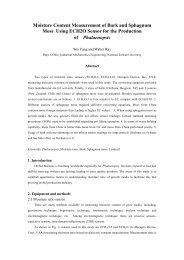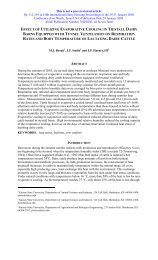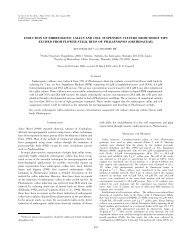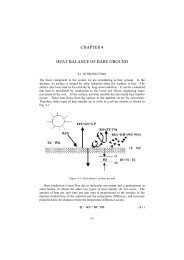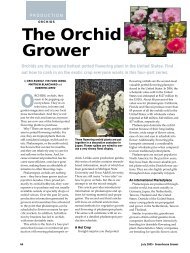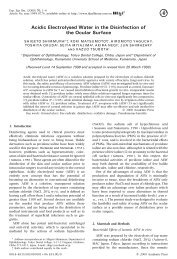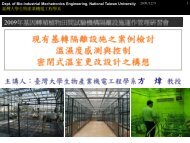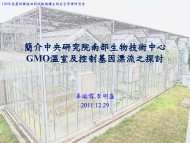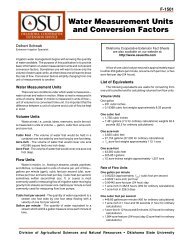Review on thermal energy storage with phase change: materials ...
Review on thermal energy storage with phase change: materials ...
Review on thermal energy storage with phase change: materials ...
- No tags were found...
You also want an ePaper? Increase the reach of your titles
YUMPU automatically turns print PDFs into web optimized ePapers that Google loves.
272 B. Zalba et al. / Applied Thermal Engineering 23 (2003) 251–283applicati<strong>on</strong> of PCM in such buildings is, because of their capability to smooth temperaturevariati<strong>on</strong>s, very promising [190,191].An interesting possibility in building applicati<strong>on</strong>s is the impregnati<strong>on</strong> of PCMs into porousc<strong>on</strong>structi<strong>on</strong> <strong>materials</strong>, such as plasterboard, to increase <strong>thermal</strong> mass [192–194].The use of PCMs to store coolness have been developed for air c<strong>on</strong>diti<strong>on</strong>ing applicati<strong>on</strong>s,where cold is collected and stored from ambient air during night, and its relieved to the indoorambient during the hottest hours of the day. This c<strong>on</strong>cept is known as free-cooling [29,195–197].Another applicati<strong>on</strong> of PCMs in buildings is thermoelectric refrigerati<strong>on</strong>. Omer et al. [198,199]have integrated a <strong>phase</strong> <strong>change</strong> material in the <strong>thermal</strong> diode to improve effectiveness of the heatsink.In order to diminish the solar gain in buildings, Ismail et al. [200,201] studied the possibility ofusing a window <strong>with</strong> a PCM curtain. This window is double sheeted <strong>with</strong> a gap between the sheetsand an air vent at the top corner; the gap can be filled <strong>with</strong> PCM that up<strong>on</strong> freezing would preventthe temperature of the internal ambient from decreasing. Similarly, Merker et al. [202,203] havedeveloped a new PCM-shading system to avoid overheating around the window area.4.4. PCM tanks vs. water tanksIn the field of solar <strong>energy</strong> <strong>storage</strong>, Cassedy [204] claims that today PCMs do not offer ec<strong>on</strong>omicsavings for <strong>thermal</strong> <strong>storage</strong> at low temperatures (50–100 °C), since these systems (paraffin)cost about the double of the cost of hot water systems. He does, however, point out the advantagesassociated <strong>with</strong> <strong>materials</strong> like paraffin, such as low corrosi<strong>on</strong>, and chemical stability.Similar results were reported previously by Farid [46].Especially the high <strong>storage</strong> density at small temperature <strong>change</strong>s can be a significant advantagein solar applicati<strong>on</strong>s and utilizati<strong>on</strong> of waste heat [32,205].Mehling et al. studied the possibility of including a PCM-module at the top of a stratified watertank. Their results stated and increase of <strong>energy</strong> <strong>storage</strong> and a better performance of the tank[206,207].Esen et al. [208] studied theoretically the effects of various <strong>thermal</strong> and geometric parameters <strong>on</strong>the whole PCM melting time for different PCMs and tank c<strong>on</strong>figurati<strong>on</strong>s. The c<strong>on</strong>figurati<strong>on</strong>s werethose of a tank <strong>with</strong> PCM packed in cylinders and the heat transfer fluid flows parallel to it; thesec<strong>on</strong>d is a tank where pipes c<strong>on</strong>taining the fluid are embedded in the PCM. Another c<strong>on</strong>figurati<strong>on</strong>used for many year is the inclusi<strong>on</strong> of the PCM in spherical c<strong>on</strong>tainers, and those in thewater tank [87,209].4.5. Other applicati<strong>on</strong>sAlthough there is a time coincidence between solar radiati<strong>on</strong> and air c<strong>on</strong>diti<strong>on</strong>ing, some heat<strong>storage</strong> is necessary for uninterrupted operati<strong>on</strong> of the chiller or to expand the operati<strong>on</strong> time, soSafarik et al. [210] developed a solar climatisati<strong>on</strong> system using an amm<strong>on</strong>ia/water absorpti<strong>on</strong>chiller <strong>with</strong> a paraffin-latent heat <strong>storage</strong>.Similar c<strong>on</strong>cept has been developed in heating, where a PCM-TES is linked to a heat pump andheat distributi<strong>on</strong> system, and significant reducti<strong>on</strong> in the capacity of the heat pump and systemannual running costs can be made [211–213].



